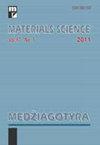Investigation of Performance Properties of Milled Carbon Fiber Reinforced Hot Mix Asphalt
IF 0.6
4区 材料科学
Q4 MATERIALS SCIENCE, MULTIDISCIPLINARY
引用次数: 0
Abstract
In this study, the mechanical behavior and resistance to moisture damage of hot mix asphalt (HMA) concrete with the addition of Milled Carbon Fiber (MCF) were experimentally investigated. For this purpose, the gradation curve within the boundaries of the Turkish highway construction specifications (HTS) has been determined. By keeping the determined gradation constant, MCF was added at different rates (1 %, 1.5 %, 2 %, 2.5 %, 3 %) by weight of the mixture. In the study, first, optimum bitumen ratios (OBR) of pure control samples (0 %-Control) without MCF and mixtures with MCF additives were determined by using the Marshall design method. To determine the OBR, samples were prepared with bitumen content of 3.5 %, 4 %, 4.5 %, 5 %, 5.5 %, and 6 % at each carbon additive ratio. The mixture samples prepared using the specified OBRs were subjected to Marshall stability (MS) and flow, as well as to retained Marshall stability (RMS), indirect tensile strength (ITS), and moisture damage resistance tests. According to the test results, it was observed that the MS values of the asphalt concrete with MCF additives increased at certain carbon additive ratios, while the flow values decreased compared to the witness sample. It was determined that the RMS and indirect tensile strength ratio (TSR) values of hot mixes with MCF-added bitumen increased and the moisture damage resistance of the mixes increased. As a result, when the optimum MCF ratio determined for the wearing course is used, it is thought that the engineering properties of HMA will improve.碳纤维粉磨增强热拌沥青的性能研究
本文对掺加磨碳纤维(MCF)的热拌沥青(HMA)混凝土的力学性能和抗湿损伤性能进行了试验研究。为此,确定了土耳其公路施工规范(HTS)边界内的级配曲线。在保持确定的级配常数的情况下,以不同的混合质量率(1%、1.5%、2%、2.5%、3%)加入MCF。首先,采用Marshall设计方法确定了无MCF纯对照样品(0 %-Control)和添加MCF混合料的最佳沥青比(OBR)。为了确定OBR,在每种碳添加剂比例下制备沥青含量分别为3.5%、4%、4.5%、5%、5.5%和6%的样品。使用指定的obr制备的混合物样品进行了马歇尔稳定性(MS)和流动测试,以及保留马歇尔稳定性(RMS)、间接拉伸强度(ITS)和抗湿损伤测试。试验结果表明,与见证样相比,添加MCF的沥青混凝土在碳添加比例一定时,其MS值有所增加,而流量值有所降低。结果表明,添加mcf沥青的热混合料的RMS值和间接抗拉强度比(TSR)值增加,混合料的抗湿损伤性能提高。因此,当采用适合磨损过程的最佳MCF比时,HMA的工程性能将得到改善。
本文章由计算机程序翻译,如有差异,请以英文原文为准。
求助全文
约1分钟内获得全文
求助全文
来源期刊

Materials Science-medziagotyra
工程技术-材料科学:综合
CiteScore
1.70
自引率
10.00%
发文量
92
审稿时长
6-12 weeks
期刊介绍:
It covers the fields of materials science concerning with the traditional engineering materials as well as advanced materials and technologies aiming at the implementation and industry applications. The variety of materials under consideration, contributes to the cooperation of scientists working in applied physics, chemistry, materials science and different fields of engineering.
 求助内容:
求助内容: 应助结果提醒方式:
应助结果提醒方式:


